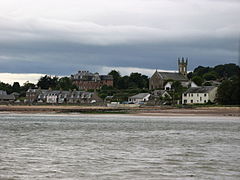Human settlement in Scotland
Rosemarkie
| |
|---|---|
 Rosemarkie seen from the beach Rosemarkie seen from the beach | |
 | |
| Population | 640 (2022) |
| OS grid reference | NH736577 |
| Council area | |
| Country | Scotland |
| Sovereign state | United Kingdom |
| Post town | Fortrose |
| Postcode district | IV10 8 |
| Police | Scotland |
| Fire | Scottish |
| Ambulance | Scottish |
| 57°35′30″N 4°06′55″W / 57.59162°N 4.11516°W / 57.59162; -4.11516 | |
Rosemarkie (Scots: Rossmartnie, from Scottish Gaelic: Ros Mhaircnidh meaning "promontory of the horse stream") is a village on the south coast of the Black Isle peninsula in Ross-shire (Ross and Cromarty), northern Scotland.
Geography
Rosemarkie lies a quarter of a mile east of the town of Fortrose. The pair make up the Royal Burgh Of Fortrose and Rosemarkie, situated either side of the Chanonry Ness promontory, about 12 miles (19 km) north-east of Inverness. Close to the village the Markie Burn has its mouth in the Moray Firth. The stream runs into the Fairy Glen, a small and steep-sided valley established as a RSPB nature reserve.
Rosemarkie fronts on a wide, picturesque bay, with views of Fort George and the Moray coastline across the Moray Firth. It has one of the finest beaches on the Moray Firth Coast Line. At the southern end of the beach is Chanonry Point, reputed to be the best location on the United Kingdom mainland from which to see dolphins.
The village is linked to Inverness by broadly hourly bus services, which are provided by Stagecoach Group.
Pictish stones
Main article: Rosemarkie StoneRosemarkie is probably best known for its collection of finely carved Pictish stones, which is one of the largest in Scotland at a single site. These 8th-9th-century sculptures, found in and around the town's churchyard, are displayed in the Groam House Museum, a converted 18th-century town-house on the High Street. The house is open in summer and charges a small entrance fee. These carved stones are evidence for a major early monastery at Rosemarkie, founded by, or associated with, Saint Moluag (d. 592) and Boniface, otherwise known as Curetán (fl. early 8th century). The sculptures include cross-slabs, shrine fragments and architectural pieces. One small fragment of a stone from Rosemarkie is in the Museum of Scotland in Edinburgh.
Notable people
- Vince Jack (1933–2006), footballer
See also
Footnotes
- "Mid-2020 Population Estimates for Settlements and Localities in Scotland". National Records of Scotland. 31 March 2022. Retrieved 31 March 2022.
- The Online Scots Dictionary
- Watson WJ Celtic Placenames of Scotland Blackwood 1926
- "Fairy Glen". RSPB. Retrieved 17 June 2022.
- Your personalised timetable - Download a full timetable Retrieved 11 June 2020.
- Full timetable. Retrieved 11 June 2020.